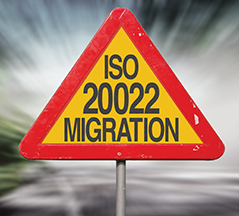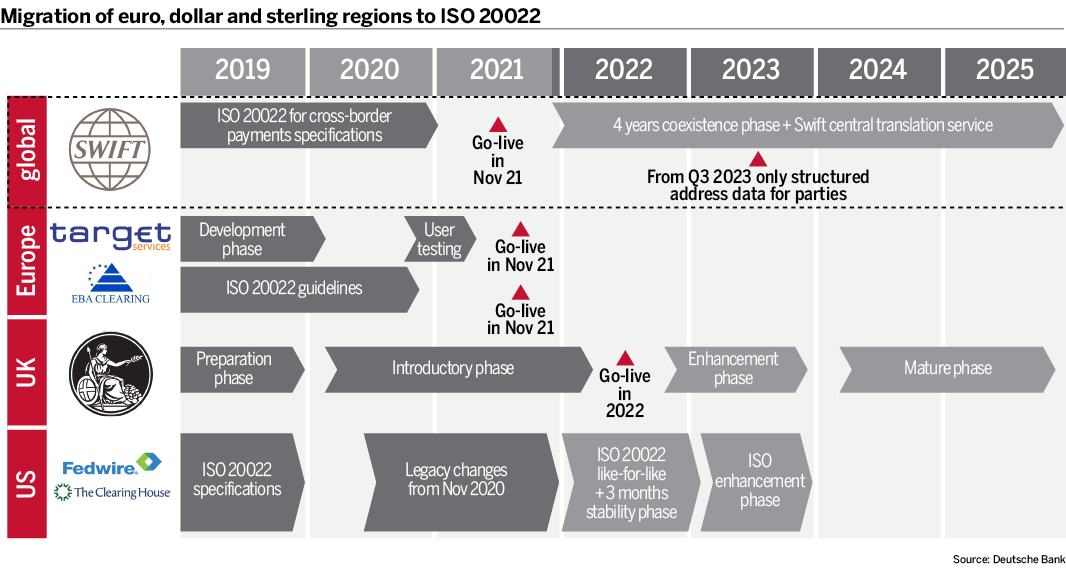ISO 20022 migration: not just an IT project
The decision by major central banks and Swift to migrate to ISO 20022 is an opportunity for banks to improve operational efficiency and reassess existing business models, says Christian Westerhaus, head of cash products at Deutsche Bank, but it will require senior-level commitment and the allocation of appropriate budgets.
Over the next five years, the world’s primary payment market infrastructures, including major central banks and Swift, which sits at the core of the financial ecosystem, will undergo significant transformational change in response to demands for increased automation and cost efficiencies, enhanced market integration and real-time services. Underpinning each of these modernisation programmes is the migration to ISO 20022.
It is a watershed moment. Not only does it lay the foundations for vastly improved payment processing efficiency and interoperability, its benefits are numerous from a customer experience and compliance perspective. The journey to ISO 20022 therefore has far-reaching implications for all banks; this is not simply another IT project.
In fact, many argue that this is the most important undertaking for the payments industry since the introduction of the Single Euro Payments Area (SEPA). Given its scale and importance, it is imperative that banks have senior-level commitment and appropriately allocate budgets, resources and project teams, given that a multitude of areas will be affected across the institution. In addition, banks should consider taking this opportunity to redesign substandard business processes and even use it as a catalyst for more extensive re-assessment of business models.
Big bang or phased approach?
ISO 20022 has already been introduced for high-value payments systems in Japan, Switzerland and China, and is established as the standard in instant payments markets following implementations in Australia, the US, Canada and Singapore. Yet there remains much focus, understandably, on the intentions of the euro, US dollar and sterling currency regions (see chart).
In Europe, the Eurosystem has set out its vision for further integration of the European financial markets, comprising three key projects: Target Instant Payment Settlement; the consolidation of Target2 (T2) and Target2-Securites (T2S); and the Eurosystem Collateral Management System.
With T2S having used ISO 20022 since 2015, T2-T2S consolidation will naturally be based on the new standard, meaning fundamental changes for the entire handling of central bank operations, minimum reserve requirements, payment transactions, secondary systems and access to all T2 services. As with T2, EBA Clearing – which operates a number of major payment infrastructures in Europe – will also migrate to ISO 20022. In terms of timing, Europe can expect a ‘big bang’ approach: from November 22, 2021, Target and EBA Clearing infrastructures will only communicate via ISO 20022.
In the US, the Federal Reserve has deemed the migration to ISO 20022 of Fedwire, the real-time gross settlement funds transfer system operated by the Federal Reserve Banks, as a key strategic initiative. However, instead of a big bang, the US plans a phased-implementation:
• Phase 1: after an initial preparation period, existing data fields will be gradually migrated to the new format in a ‘like-for-like’ approach;
• Phase 2: Fedwire will offer conversion services to allow banks that have already migrated to communicate with those which have not;
• Phase 3: As of November 2023, all banks will gradually move to ISO 20022.
The Clearing House is following the Fed’s phased approach, although it is advocating a full migration to ISO 20022 as soon as Swift has made the necessary ISO messages available.
In the UK, the Bank of England – which operates Chaps, the real-time gross settlement system for the clearing of central bank money – has outlined its intention to establish a new architecture based on ISO 20022. In addition, the national Payment Systems Regulator, the economic regulator for the UK’s £7500bn ($9525bn) payment systems industry, has confirmed that Bacs and Faster Payments – other key payments market infrastructures – will also move to the new standard.
The Bank of England has set out four phases for the migration:
• The preparation phase is set to be completed by the beginning of 2022;
• The introductory phase, a like-for-like approach that will run until mid-2023;
• The enhancement phase, due to be completed by the first quarter of 2024;
• The mature phase.
Turning to Swift, the bank messaging consortium has already made ISO 20022-based XML messages available, which are currently exchanged within a closed user group via the Swift network. From November 2021, shortly before the migration of the eurozone, Swift will start completely moving to the ISO 20022 format over a four-year period. In order to facilitate the migration from the current standard MT messages, there will be a temporary co-existence phase enabled by a conversion service.
Seeking out opportunities
ISO 20022 migration is not mandatory but choosing to take no action could mean losing access to central bank money, which would have adverse effects on the fulfilment of minimum reserve requirements and liquidity management.
However, the real value of the migration to ISO 20022 will be realised if banks take it as an opportunity to re-assess their business models, and provide their customers with a more robust, reliable and secure payments. Indeed, for banks to keep up with the expectation of near-instant payments around the clock, a next-generation market infrastructure is needed that can offer seamless and quicker payments processing in support of digital business models.
ISO 20022 messages allow for the transfer of far richer payment information compared with existing formats, given that extra data components can be sent with each transaction. As such, payment transparency is greatly increased, a considerable advantage when you consider the need to rapidly process large amounts of data for anti money-laundering compliance and fraud prevention purposes. This improved visibility over payments also enables banks to provide an upscaled customer service, including digital – i.e. straight-through processed – reconciliation.
However, it is not just banks that stand to benefit. Corporate clients too have much to gain from standardised payment, reporting and exception handling messages, facilitating end-to-end automation, from invoicing to liquidity management.
The benefits of standardised messaging are borne out in the figures. The European Commission suggests, for example, that the introduction of SEPA has saved about €21.9bn per annum, with ISO 20022 playing a significant role.
Move first, move fast
Yet, to unlock the full capability of ISO 20022, a complex migration process must be carried out. To effectively plan timelines, banks must consider, among other factors, whether external providers are to be used as part of the service delivery, how many transactions will be affected and, of course, whether there are any wider implications for the business beyond payment transactions.
Certainly, ISO 20022 migration will have an impact that goes far beyond core payments processing, affecting peripheral systems such as anti-crime applications, billing, account reporting, nostro reconciliation and archive systems. It poses more than just a cash management challenge, as is often presumed, with everyone from senior management to human resources needing to be aware of the project and its impact. From an infrastructure perspective, all banks systems and databases will need to be capable of processing data volumes two or three times larger – and at greater speed – if intraday liquidity management and real-time payments are to be achieved.
Given the size of the challenge, some banks may consider shortcuts. A ‘converter’, for example, placed at the inlet and outlets of the payments process can be used to convert legacy payment messages into ISO 20022 formats. Yet, this method comes with its own pitfalls, often resulting in useful data being lost in translation.
Therefore, the first step on this journey must be to develop a clear migration strategy: a consideration of connections to the respective market infrastructure; a timeline for migration (whether to complete in steps or go for a big bang); a decision on whether to migrate the bank’s entire architecture or seek some tactical workarounds; and an assessment of the necessary IT solutions (and whether these should be built in-house or sourced from elsewhere).
Such a migration will clearly require a significant investment of time and resources. Yet acting now could bring the benefits of harmonised standards earlier, amortising the investments on the bank side and securing end-to-end efficiency of the payments ecosystem.
The ISO 20022 migration project is the payment industry’s greatest challenge since the introduction of the euro – but also its greatest opportunity.




